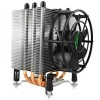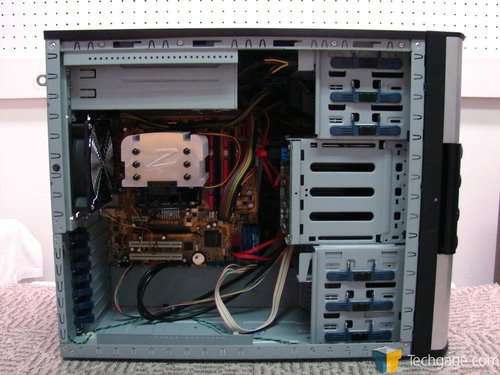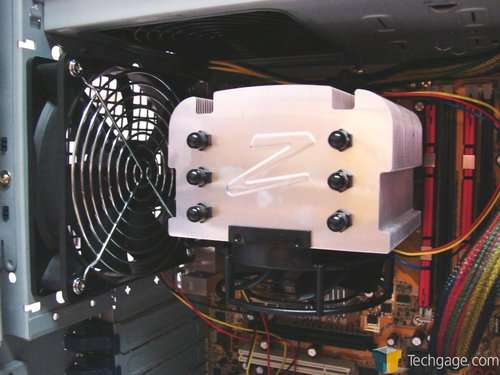- Qualcomm Launches Snapdragon 4 Gen 2 Mobile Platform
- AMD Launches Ryzen PRO 7000 Series Mobile & Desktop Platform
- Intel Launches Sleek Single-Slot Arc Pro A60 Workstation Graphics Card
- NVIDIA Announces Latest Ada Lovelace Additions: GeForce RTX 4060 Ti & RTX 4060
- Maxon Redshift With AMD Radeon GPU Rendering Support Now Available
OCZ Vanquisher CPU Cooler

There’s an ever-increasing variety of CPU coolers out there, each competing for your dollar with advanced features, high performance, and bling. We take a look at OCZ’s latest, the Vanquisher, a smaller tower-style cooler that features a large fin structure and a 92mm, frameless fan.
Page 3 – Thermal Performance; Noise
OCZ’s Vanquisher promises high-performance cooling for budget-minded enthusiasts, and boasts an impressive feature set for its price. It’s also pretty sharp-looking as well – no one can say that the Vanquisher fails to look the part. However, these claims are nothing if the performance isn’t there. Here, we’ll test the thermal performance of the unit, and also assess its noise output. We don’t expect the Vanquisher to obliterate its high-dollar competition from the likes of Zalman and Scythe – rather, we use a stock Athlon 64 CPU heatsink as our reference point. While performance champions come and go, the stock Athlon CPU cooler is like a bellybutton – everybody has one.
- Test System
- CPU: AMD Athlon 64 X2 4200+ EE (65W)
- Motherboard: ASUS M2NPV-VM (nForce 430, GeForce 6150)
- RAM: 1GB (2x512MB) A-Data Vitesta DDR2-1000 @ DDR2-800
- Hard Drives: Western Digital 160GB, 7200RPM, 8MB Cache, SATA2
- PSU: OCZ StealthXStream 600W
- Other Hardware: Cooler Master iTower 930, modified
The test rig for this test is our trusty modified Cooler Master iTower 930. Essentially, it’s an iTower 930 server case with every unnecessary component removed. While our photos depict the case with its side panels removed, all testing was performed with the side panel in place. The modified iTower 930 provides the same level of system airflow as a typical enthusiast PC, with a 120mm rear case fan and a PSU that also has a 120mm fan.
In all testing, the ASUS Q-Fan thermal CPU fan control and AMD Cool n’ Quiet were both disabled. To ensure a level playing field for both heatsinks, we wiped whatever thermal compound was on the bottom of the Vanquisher and tested both heatsinks using Arctic Silver 5, with a ball-bearing-sized amount spread into a thin layer using a razor blade. Each heatsink was tested by first allowing the system approximately 30 minutes to reach its idle temperature, and then hitting the system hard with a round of 3DMark06, with the peak CPU temperature being reached at the end of the second CPU rendering test.

At idle, the difference between the two heatsinks is minimal – only a single degree. However, when the system was loaded heavily with the multithreaded 3DMark06 CPU rendering test, the Vanquisher’s lead increased to three degrees. While these margins aren’t huge, remember that testing was done with a low-power processor, instead of a fire-breathing 120-watt quad-core behemoth. In terms of percentages, the OCZ Vendetta manages an 8.1% temperature decrease when compared to the stock AMD heatsink. This performance doesn’t exactly blow the doors off other coolers we’ve tested – but it’s respectable nonetheless.
One area where the OCZ Vanquisher cooler really delivers is silence. At full honk, the Vanquisher produces about as much noise as an ordinary case fan at 12 volts. However, when the motherboard’s Q-Fan option was enabled, and with all other fans in the system stopped, the Vanquisher cooler was inaudible. A quick check of the BIOS confirmed that the Vanquisher’s fan idled near 900 RPM.
Its noise output easily dropped below the noise floor of my quiet test room – with all other noise sources shut off (including HVAC). Therefore, by our standards the Vanquisher qualifies as a ‘silent’ product. We realize this is a fairly subjective standard, but it’s the standard we feel is most likely to be applied by anyone without expensive measurement equipment.
|
|
Support our efforts! With ad revenue at an all-time low for written websites, we're relying more than ever on reader support to help us continue putting so much effort into this type of content. You can support us by becoming a Patron, or by using our Amazon shopping affiliate links listed through our articles. Thanks for your support!






